Holistic Pregnancy & Childbirth

How Has Childbirth Changed in This Century?
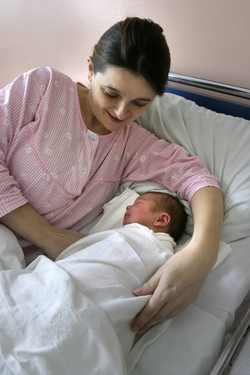 Childbirth itself has not changed at all! Babies are still born today in the same way that that they have been born for generations. But many things associated with childbirth have changed, including:
Childbirth itself has not changed at all! Babies are still born today in the same way that that they have been born for generations. But many things associated with childbirth have changed, including:
- Birthing parent's expectations of childbirth
- Pain management options
- The economics of childbirth and the system of healthcare
- The technology used during pregnancy and birth.
These factors have greatly changed birthing person's childbirth experiences.
How have expectations of childbirth changed?
Today, a birthing parent having a baby in an industrialized nation can reasonably expect that both they and their baby will have a healthy journey through pregnancy and birth. Childbearing is generally safe and does not represent illness or disability. A hundred years ago, many birthing parents faced childbirth with some fear because they knew of a parent or baby who had died. Today, however, there is some expectation that changes in childbirth technology not only minimize risks that might have led to death or disability a century ago, but promise a perfect outcome.
Additionally, in many parts of the world today, birthing people can plan their pregnancies and tend to have fewer children than a century ago. This has created a culture where each pregnancy and baby generates intense attention.
Expectations of pain management have also changed. One hundred years ago, most children throughout the world were born at home. Although many factors contributed to the movement of childbirth from the home to the hospital, one important reason for this change was the development of pain-reducing childbirth anesthesia, which was only available at the hospital.
When did natural (unmedicated) childbirth become popular?
During the 1950s and 60s, people became more aware of the problems associated with heavy anesthesia during labor. Dense anesthesia:
- Had negative physical effects on birthing parents and their babies (see more below in How has pain management changed?)
- Left birthing parents unable to play a role in their own care and that of their babies.
In addition the use of heavy anesthesia shifted control of childbirth from birthing parents (the birthing parent and their midwife), to the physician, (generally male at that time). The growing women's movement drew attention to this power change and set the stage for the natural childbirth movement. There was a strong sentiment that women and birthing people, not their healthcare provider, should be in charge of the labor experience.
Advances in non-medicinal pain relief
Read more about pain managementAt first glance, the natural childbirth movement may have seemed a step backward in terms of comfort in labor and birth, but several advances had been made in non-medicinal methods of pain relief. Early proponents of natural childbirth (Dick-Read, 1943; Karmal, 1959; Lamaze, 1970; Leboyer, 1975; and Bradley, 1978) developed programs to prepare birthing people for childbirth that included relaxation, patterned breathing, hypnosis, and water immersion. Encouraged by the work of these early experts, birthing people began to reclaim their autonomy in the birth process.
Note that advances in medical treatment of pain have also resulted in pain management techniques that are safer and less disruptive to the process of labor than earlier methods had been, although these are still not risk free.
Changes in childbirth
Pain management
Pain management techniques have evolved over the last century.
How has pain management changed throughout time?
When childbirth occurred in the home, pain management was dependent on the skill of a woman's midwife or her family in helping her through childbirth.
- In the late 1800s, the labor analgesic "Twilight Sleep," a combination of morphine and scopolamine that both relieved pain and caused women to forget most of their labor and birth, became available in the hospital. At first, this option was only available to wealthy women who could pay for hospital care, but women's rights activitists advocated its availability for all women.
There were problems, however, with forms of dense anesthesia for childbirth. Women who were heavily medicated had difficulty communicating and difficulty pushing. Forceps and cesarean sections were often necessary to complete the birth. Babies who were born to heavily medicated women were born sleepy, with a decreased drive to breathe, and often needed resuscitation.
- The development of spinal anesthesia, known in the mid-20th century as a "saddle block," helped relieve the pain of delivery, but often left women unable to push, again necessitating forceps deliveries.
- Anesthesiologists have continued to refine spinal anesthesia techniques, and in most Western hospitals today, many women may choose to have some form of epidural or spinal anesthesia for birth. Risks and benefits of these techniques are more fully discussed in the topics Why Should I Consider a Holistic Approach to Pregnancy and Childbirth? and What Factors Influence the Normal Progression of Labor?.
Economics of childbirth
During the 20th century, childbirth shifted to the hospital for reasons that are in part economic.
How have the economics of childbirth changed?
During the 20th century, childbirth shifted to the hospital for several reasons:
- The availability of pain medications in the hospital.
- The belief that physicians were the most qualified to attend births.
- Women's and physician's beliefs that hospital births were safer.
- The increased ability of families in the United States to pay for what they felt represented the best care (physician and hospital care).
Childbirth has remained in the hospital for reasons that are largely economic.
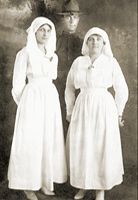 Throughout time, midwives have provided the majority of maternity care around the world, however, the late 1800s and early 1900s represented a time of change. The development of forceps in the mid 1700s, which were only used by physicians, introduced the doctor to maternity care.
Throughout time, midwives have provided the majority of maternity care around the world, however, the late 1800s and early 1900s represented a time of change. The development of forceps in the mid 1700s, which were only used by physicians, introduced the doctor to maternity care.
Physicians were called to births when progress was slow or there were other problems, and thus their introduction to childbirth was in problem situations where the outcome was often poor.
At the same time, the medical profession was shifting its professional basis. Organized schools of medicine replaced apprenticeships as the preferred method of learning and obstetrics was included as an area of study.
Physicians in the U.S. organized the American Medical Association in 1847, which sought to promote the wellbeing of its profession. For the first time, under the influence of the AMA, states passed laws regulating who could practice medicine. In general, this was a benefit to healthcare consumers, as it helped keep unqualified people from claiming to practice medicine, and it lead to the accreditation of medical and other professional schools. However, in the early 1900s these laws nearly put an end to the practice of midwifery as physicians sought the "business" of caring for pregnant women, using the medical practice acts to limit the activity of midwives. (A busy rural midwife in the early 1900s was estimated to make $678, compared to the estimated physician's salary at the time of $730, thus maternity care was a lucrative practice to seek!)
Physicians and hospitals also recognized that if a positive relationship was established with a pregnant woman, it would influence where she sought care for herself and her family for a lifetime. This provided another motivation to seek pregnant women as clients and is still a motivation today.
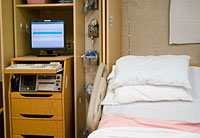 Beginning in the early 20th century and continuing today, hospitals recognized that they could gain income from providing services as well as providing a place to give birth. Epidural or spinal anesthesia, labor inductions, cesarean sections, even the placement of IV lines are a source of additional revenue for both the hospital and the practitioners involved (physicians, midwives, and anesthesiologists). From the perspective of the hospital, a low-intervention natural childbirth is not the most financially profitable
Beginning in the early 20th century and continuing today, hospitals recognized that they could gain income from providing services as well as providing a place to give birth. Epidural or spinal anesthesia, labor inductions, cesarean sections, even the placement of IV lines are a source of additional revenue for both the hospital and the practitioners involved (physicians, midwives, and anesthesiologists). From the perspective of the hospital, a low-intervention natural childbirth is not the most financially profitable
System of healthcare
The system of healthcare in the United States has changed dramatically over the past century.
How has our system of healthcare changed?
The system of healthcare in the United States has changed dramatically over the past century. At the turn of the last century, people paid for their healthcare from their own pockets. As employer-provided health insurance and public health insurance programs such as Medicare and Medicaid developed, women's access to healthcare improved, but the cost of healthcare has increased at a rate well above the rate of increase in our incomes.
Most individuals now receive their health insurance through a managed care program of some sort, either individually purchased, employer, or government provided. A managed care program attempts to balance access to quality care with controlling healthcare costs. Managed care has introduced some key changes for women seeking prenatal care, among them:
- The choice of providers may be limited.
- Most midwives and physicians practice in groups. While this is beneficial to an individual provider, as it prevents them from potentially working an unsafe number of hours, it may mean that the provider that a woman has seen through her pregnancy may not be available when she goes into labor.
Medical liability has also had an impact on current prenatal care and birth. The liability insurance premiums for providers of obstetric care are expensive and so is being sued. Consequently, practitioners seek any legal protection they can find. Following the standards of care established by the American College of Obstetricians and Gynecologists (ACOG) may offer some protection from liability. Practitioners feel more protected if the standards are cautious, even if they are not well founded in research. However, this may lead to an overuse of birth technologies.
How has birth technology changed?
A typical physician-attended hospital birth today looks very little like a home birth of a century ago. The past century has brought numerous changes in childbirth technology, including tests and procedures during pregnancy, how the baby's wellbeing is monitored during labor, and birth practices. There are pros and cons to many of these changes.
Tests and procedures
Providers offer women an array of screening and diagnostic tests during their pregnancy.
Tests and procedures
Providers generally offer women an array of screening and diagnostic tests during their pregnancy. (A screening test identifies an increased risk of a problem. A diagnostic test diagnoses the problem being considered. For example, the prenatal Quad Screen may identify a woman as having an increased risk of having an infant with Down Syndrome, but does not provide a diagnosis. The diagnosis can only be made with an amniocentesis).
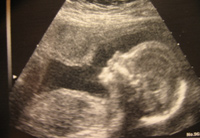 It is now possible to identify more problems and risks earlier in pregnancy than ever before. This means that woman and their families have more decisions to make. For each offered test or procedure, women must decide if they want the test, and if so, what they are willing to do based on the results. For some women, the increased options for prenatal testing may lead to an increase in anxiety. All pregnant women desire a healthy baby, and to receive test results during pregnancy that indicate a potential problem leads to increased stress.
It is now possible to identify more problems and risks earlier in pregnancy than ever before. This means that woman and their families have more decisions to make. For each offered test or procedure, women must decide if they want the test, and if so, what they are willing to do based on the results. For some women, the increased options for prenatal testing may lead to an increase in anxiety. All pregnant women desire a healthy baby, and to receive test results during pregnancy that indicate a potential problem leads to increased stress.
One perspective that may be helpful is to consider if the prenatal testing offered will be useful in making subsequent decisions. Some women don't want specific testing, because the information would not change what they plan to do. Some women want all the available information to help them make plans for potentially caring for a child with a disability, or to help them make a decision regarding pregnancy termination.
A full discussion of all of these tests available during pregnancy is beyond the scope of this module, but they are briefly outlined in this short guide to tests.
Monitoring the baby's wellbeing
Intermittent monitoring during labor is the recommended practice, but many hospitals monitor continuously.
Monitoring the baby's wellbeing
The baby's wellbeing can be assessed by several methods:
- A century ago, the baby could only be monitored by using a stethoscope, or a specially designed fetal stethoscope, and a baby can still be monitored in this way today.
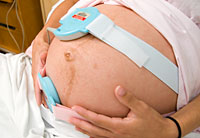 In the 1960s, the electronic fetal monitor was introduced, that provided the physician or midwife with a paper record of the baby's heartbeat. Providers can monitor electronically by either using an external device placed on the mother's abdomen, which uses Doppler ultrasound to detect the baby's heartbeats, or with an internal device placed directly on the baby's head during an internal exam, which measures the electrical current generated by the heart.
In the 1960s, the electronic fetal monitor was introduced, that provided the physician or midwife with a paper record of the baby's heartbeat. Providers can monitor electronically by either using an external device placed on the mother's abdomen, which uses Doppler ultrasound to detect the baby's heartbeats, or with an internal device placed directly on the baby's head during an internal exam, which measures the electrical current generated by the heart.- A handheld Doppler device can be placed on the mother's abdomen to listen to the heartbeat.
The American College of Obstetricians and Gynecologists (ACOG) has outlined specific protocols for monitoring the heartbeat of a baby during labor and specific criteria have been developed for evaluating the heart rate. Some points about monitoring:
- The ACOG protocols reflect research that shows that there is no benefit for low-risk women in using continuous monitoring as opposed to listening to the baby's heart rate intermittently
- Continuous monitoring limits a woman's mobility and her ability to assume positions of comfort. If there is no remote telemetry monitoring available, she may be unable to walk or to use a shower or tub.
- Continuous monitoring has also been associated with an increase in other interventions, such as forceps, vacuum extractors, and cesarean section, without evidence of benefit to the baby.
Despite this evidence and the support for intermittent monitoring by the ACOG protocols, most laboring women in the hospital today are monitored continuously throughout their active labor. As a result, many labor nurses have grown so accustomed to continuous monitoring that they are unfamiliar with the option of intermittent monitoring.
Birth practices
Cesarean sections and inductions of labor have become much more common.
Birth practices
Several birth practices have also changed in the past 100 years. Although cesarean sections and forceps were used early in the 20th century, their frequency was low. Today:
- The rate of cesarean sections is approaching 30% in the United States. A very recent trend is the elective cesarean section, that is, a cesarean section done without a current medical indication but that might potentially prevent future problems such as incontinence.
- The development of the vacuum extractor has decreased the use of forceps, although both are still used frequently.
- Inductions of labor are becoming increasingly more common, and today, an estimated 40% of all women are induced, despite estimates that only 10% of women need to be induced for a medical reason.
Fortunately, some birth practices introduced in the past century, such as shaving a woman's pubic hair or routinely cutting an episiotomy, have been shown ineffective and discontinued. However, other practices, such as the routine placement of an IV, permitting a laboring women to have only ice chips, and not allowing her to use a tub if her bag of waters has broken, have continued to be a standard of care, even though not supported by research.
What is clear from the research is that although technological interventions may be helpful in many situations, their routine use for all pregnant and birthing women is not warranted.
How do all these changes affect my baby and me?
The good news about having a baby today is that a wealth of information is readily available: from your provider, on the web, in bookstores, and at the library.
Medical ethics have also changed. The paternalistic and well-meaning "doctor knows best" attitude of a century ago has been replaced with a respect for the autonomy of the birthing woman and an understanding that all women must be provided with information and give consent before medical treatment.
Most midwives and physicians have a strong desire to do just that. However, a few providers, although well-meaning, might provide fear-based, limited information, particularly if a woman is identified as being high-risk. Imagine being told, "unless you have this procedure, your baby might die" without additional information about the actual likelihood of death or disability, or alternatives to the procedure. How would you respond in such a situation? Fortunately, these practices are rare, and, even for women who have identified risk factors, many options and alternatives remain available to her during pregnancy and childbirth.
 Your role
Your role
It is important to discuss any proposed tests, treatments, or interventions with your midwife or doctor. For many women, this is challenging. Think about the last time you had a talk with an authority figure, or someone whose area of expertise was different from your own. Chances are you found it a bit intimidating. Now add to this the challenge of having such a discussion during labor, a time when women may feel especially vulnerable. Clearly, the discussion of childbirth choices should begin during the prenatal period.
With this in mind, research prospective plans of care or treatment options, ask informed questions, and expect to be a full participant in decision-making during your pregnancy and birth. Information and discussion can help you identify when childbirth technology might offer the best outcome for you and your baby, or when a less technological approach would be more appropriate.

Lorinda and Marcus's Choices
Lorinda and Marcus moved to a new town early in Lorinda's pregnancy. They knew that they wanted to find a provider who involved them fully in Lorinda's prenatal care and who would support their choices in holistic and alternative healthcare measures. They also knew that they wanted a provider who did not routinely induce labor, in a birth center where waterbirth was an available option. The first midwife that they saw in their new town supported their holistic choices, but did not offer waterbirth. However, she helped them find a midwifery practice that did include waterbirths.
American College of Obstetricians and Gynecologists (ACOG). (2005). Intrapartum fetal heart rate monitoring. ACOG practice bulletin No. 70. 2006 Compendium of Selected Publications. Washington, D.C.: ACOG.
Burst, C.G. (1995). Catching babies: The professionalization of childbirth, 1870-1920. Cambridge, MA: Harvard University Press.
Rooks, J.P. (1997). Midwifery & childbirth in America. Philadelphia: Temple University Press.
Thacker, S.B., Stroup, D., & Chang, M. (2001). Continuous electronic fetal heart rate monitoring for fetal assessment during labor. The Cochrane Database of Systematic Reviews, Issue 2, Article No. CD000063.
Wagner, M. (2006). Born in the USA: How a broken maternity system must be fixed to put women and children first. Berkeley: University of California Press.
Additional Readings
Works by Contemporary Childbirth Experts (Available in bookstores and libraries):
Active Birth: The New Approach to Giving Birth Naturally, Revised ed. (1992). Janet Balaskas. Harvard Common Press.
Birthing from Within (1998). Pam England, CNM. Partera Press.
Immaculate Deception II: Myth, Magic & Birth (1994). Suzanne Arms. Celestial Arts.
Ina May's Guide to Childbirth (2003). Ina May Gaskin. Bantam.
Natural Childbirth the Bradley Way, Revised ed. (1996). Susan McCutcheon-Rosegg. Plume.
Our Bodies, Ourselves: Pregnancy and Birth (2008). Boston Women's Health Book Collective. Simon & Schuster.
Pregnancy, Childbirth and the Newborn: The Complete Guide (2001). Penny Simkin. Meadowbrook.
The Birth Partner, 2nd ed. (2001). Penny Simkin. Harvard Common Press.
The Official Lamaze Guide: Giving Birth with Confidence (2005). Judith Lothian, & Charlotte DeVries. Meadowbrook.
The Thinking Woman's Guide to a Better Birth. (1999). Henci Goer. Perigee Trade.
Updated Works by Natural Childbirth Pioneers (Likely found in the library, but may be at some bookstores or available from used-book sellers):
Birth without Violence: The Book That Revolutionized the Way We Bring Our Children into the World (2004). Leboyer, F.
Childbirth Without Fear: The Original Approach to Natural Childbirth (1994). Dick-Read, G., Wessel, H., & Ellis, H.F. HarperCollins.
Husband-Coached Childbirth: The Bradley Method Of Natural Childbirth, 4th ed. (1966). Bradley, R.A., Hathaway, M., Hathaway, J. Bantam Books.
Immaculate Deception: A New Look at Women and Childbirth in America
(1977). Arms, Suzanne.Painless Childbirth: The Lamaze Method (1984). Lamaze, F.
Thank You, Dr Lamaze (2005). Marjorie Karmel, M., & Karmel, A. London: Pinter & Martin.